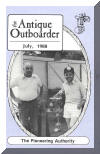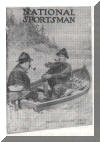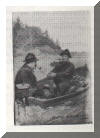|

Home
Our domain name aomci.org was donated by Alison
Kiellar in honor of Kenneth Kiellar.
|
 Dedicated to the Preservation
and Restoration of
Antique Outboards
|
 |
Of Historical Interest
The Original Outboard Motor
By Bob Zipps |
|

"Me and My Buddy Gary"
Dick Fuchs
and
Gary "Radar" Burghoff
(click on pictures for larger
image)
|
A few months
ago while I was at an antique show, I was going by a booth which had a pile
of old magazines on the table. The magazine on top of the pile caught my
eye because there was a picture of a horizontal cylinder Waterman on the
back cover. It was actually a full page ad for Waterman. The picture is in
full color and shows two fishermen motoring home in a rowboat after a fine
days fishing. I picked up the magazine and studied the ad, and then turned
the magazine over to see what the name of the publication was. To my
surprise, the same photo that was on the back cover was also on the front
cover. The name of the magazine is the "National Sportsman" and it stated
that it was the "Special Boating Issue." The date is April, 1916. I
thumbed through the magazine and it had a lot of great ads, but the real
surprise was an article titled "A Few Words About The Original Outboard
Motor". I looked to see who the author was, and it was a real shocker. The
article was written by C.B. Waterman. Needless to say I bought the issue.
What a stroke of luck that this particular issue would be on top of a pile
of magazines that I never would have gone through. Here is that article.
|
| "The first germ
of the portable marine motor idea came to me in the year 1903 while I was a
law student at New Haven. That was the year when motor-cycles first came
out, and I was among the first to procure one. After the fashion of those
early vehicles, my motor-cycle refused to work properly one day, so I lugged
it up to my room to examine it and discovered the cause of the trouble. |

Front cover of the April 1916 issue
of the National Sportsman. Note that it is the
Special Boating Issue. |
While taking it apart and overhauling it, the idea occurred to me that such
a motor might possibly be used on my rowboat when I went on fishing trips.
Every summer I spent a part of my vacation at Spruce Harbor on the north shore
of Lake Superior, and from there I had a very strenuous row of about five
miles to my favorite fishing grounds. It seemed to me that if this motor
would run a bicycle, a similar motor could be rigged up with a propeller and
rudder to run my rowboat.
|
| For
the next three years or so, I experimented during every spare moment with
this idea. My friends laughed at my tinkerings. The scheme seemed utterly
ridiculous to them. But I kept working against what they considered
insurmountable odds, and I admit it was not such a simple scheme as your
might imagine nowadays. At that time internal combustion engines of any
kind were still very crude affairs - they were far from being in their
present highly developed state. But I was positive that I had a practical
idea. So I persevered, and after continual experimenting and countless
disappointments my dream became a reality. My motor worked. |
| One bright summer
day in the year 1906 my father and I took the first trip in our good old
rowboat operated by the very first portable outboard motor, towing behind us
another boat carrying the members of the party. We made the five mile trip
in about 35 minutes, breaking all rowboat records. |
|

Rear Cover which is a full page
Waterman Ad.
Note that the front
and rear cover
photographs are identical. |
That same year, realizing
that my idea was practical, we started a factory and began putting the
Waterman Porto Motor on the market. Of course, it was heralded with a great
deal of skepticism at first. Engine-makers, in particular, looked upon this
new invention as a mere "joke." The first four of five years were filled
with hardships. Manufacturing difficulties had to be faced and fought, the
public had to be educated to the value and usefulness of this new device,
the ridicule of doubters had to be overcome. But each year, the sales came
in bigger and bigger, each year the motor itself was improved and perfected,
each year prospects looked brighter and more encouraging. |
|
Engine-makers now began to realize the actual value of the portable motor -
the need for it - the big demand - the vast possibilities. A host of
competitors sprang up overnight, as it were. But the Waterman Porto had had
a five years start - five years in which to test the motor in actual use,
not merely in laboratories - five years to find out just how to meet every
possible contingency - five years in which to perfect every detail.
From the first I have been satisfied only with the very
best, never subordinating quality for profits. I have built my motor to
give real service at all times, under any conditions and in any environment,
and it still stands as the motor that lasts a lifetime. Then, too, it has
always been my firm policy to keep abreast with the latest advances in
engineering science, and I have never hesitated to adopt new improvements
from automobile and aeroplane motor designs. As a result, the Waterman
Porto still continues at the very top in the field of portable marine
motors." |
|
This article substantiates my previous conclusion that the Waterman Outboard
Motor was in production in 1906. Previously, 1907 was thought to be when
Waterman went into production, but now it is known that 1907 was the first
full year of production. One thing that bothered
me about the Waterman article was the mention of a rudder in the last
sentence of the second paragraph. Waterman wrote, "It seemed to me that if
this motor would run a bicycle, a similar motor could be rigged up with a
propeller and rudder, and used to run my rowboat." Of course, Waterman's
first motor did not have a rudder. The Waterman Outboards that were being
made at the time the article was written had a rudder. It gives you the
impression that Waterman really didn't write this article. Other
alternatives are that, Waterman my have not recalled the details correctly,
or that the term rudder was being used loosely. Researching the latter
alternative, I checked the 1907 Waterman Catalog and it says, "Also note
Starting Crank and Bottom Clamp in which the motor pivots, allowing Motor to
swing from side to side, forming his own rudder." It is possible that when
Waterman was dreaming up his motor, he considered his whole motor the
rudder. It certainly has a tiller like a sail boat rudder and it pivots and
is supported like a sailboat rudder. I have to believe that is what
Waterman meant in his article. See you in the next issue of the Antique
Outboarder.
home |
|

